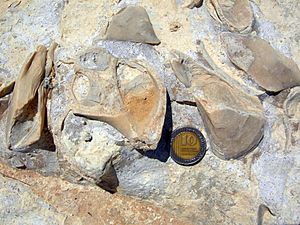Paleobiology facts for kids

Paleobiology is a fascinating branch of science that studies ancient life on Earth. It focuses on animals, plants, and tiny microbes that lived long ago. These ancient living things are found preserved in rocks as fossils. Paleobiology combines the study of biology (life) with the study of these amazing fossils.
By looking at fossils, paleobiologists can learn how life has changed over millions of years. They discover what ancient creatures looked like, what they ate, and how they lived. It's like being a detective, piecing together clues from the distant past!
Contents
Branches of Paleobiology
Paleobiology has many different areas of study. Each one focuses on a special part of ancient life or how fossils form.
Studying Ancient Life Forms
- Paleobotany: This is the study of ancient plants. Paleobotanists look at fossil leaves, wood, and seeds to understand old forests.
- Paleozoology: This branch focuses on ancient animals. It includes studying everything from tiny insects to huge dinosaurs.
- Micropaleobiology: This area looks at extremely small fossils, like those of microbes and tiny plankton. You need a microscope to see them!
Understanding Ancient Environments
- Paleoecology: This field uses fossils to learn about ancient environments. Scientists figure out what the climate was like and how different creatures lived together.
- Paleoichnology: This is the study of "trace fossils." These are not body parts, but signs of ancient life, like footprints, burrows, or bite marks. They show how animals behaved.
How Fossils Form and Change
- Taphonomy: This branch studies how living things become fossils. It looks at all the steps from when an organism dies to when it is found as a fossil.
- Paleobiochemistry: This area examines the chemical remains found in fossils. It can tell us about the original molecules of ancient life.
- Stratigraphic paleobiology: This looks at how fossils are arranged in different layers of rock. This helps scientists understand the timeline of life on Earth.
- Evolutionary developmental paleobiology: This field studies how animals changed and developed over long periods. It combines the study of fossils with how living things grow and evolve.
History of Paleobiology
The idea of paleobiology started to grow in the late 19th century. A scientist named Baron Franz Nopcsa von Felső-Szilvás is often seen as one of its founders. He worked at the University of Vienna.
At that time, many geologists were mainly interested in putting together bones of ancient animals. But Nopcsa wanted to do more. He tried to understand how these ancient animals actually lived and behaved. He looked at their bones and fossils to figure out their lifestyles, not just their shapes. This new way of thinking helped create the field of paleobiology.
Images for kids
-
Brachiopods and bryozoans in an Ordovician limestone, southern Minnesota
See also
 In Spanish: Paleobiología para niños
In Spanish: Paleobiología para niños


